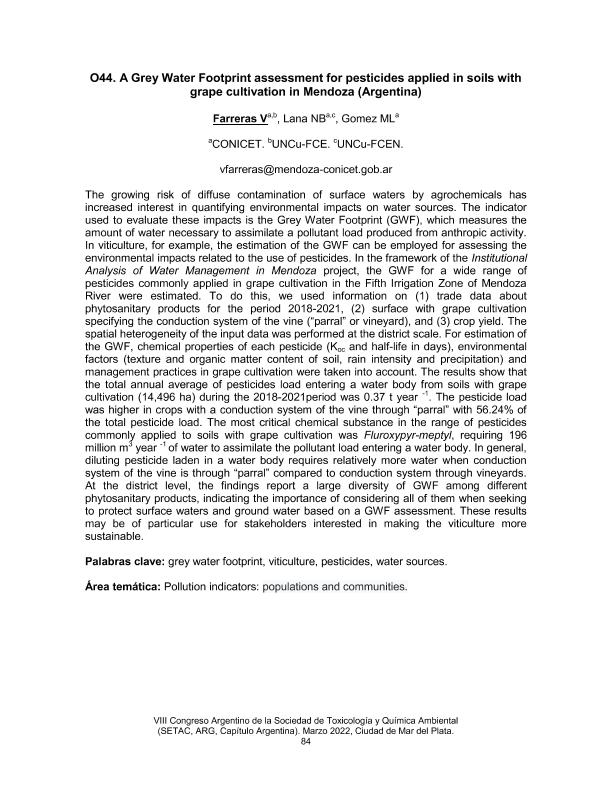Mostrar el registro sencillo del ítem
dc.contributor.author
Farreras González, Verónica Inés

dc.contributor.author
Lana, Nerina Belén

dc.contributor.author
Gomez, María Laura
dc.date.available
2024-01-03T19:27:27Z
dc.date.issued
2022
dc.identifier.citation
A Grey Water Footprint assessment for pesticides applied in soils with grape cultivation in Mendoza (Argentina); VIII Congreso Argentino de la Sociedad de Toxicología y Química Ambiental; Mar del Plata; Argentina; 2022; 84
dc.identifier.isbn
978-987-811-035-6
dc.identifier.uri
http://hdl.handle.net/11336/222345
dc.description.abstract
The growing risk of diffuse contamination of surface waters by agrochemicals has increased interest in quantifying environmental impacts on water sources. The indicator used to evaluate these impacts is the Grey Water Footprint (GWF), which measures the amount of water necessary to assimilate a pollutant load produced from anthropic activity. In viticulture, for example, the estimation of the GWF can be employed for assessing the environmental impacts related to the use of pesticides. In the framework of the Institutional Analysis of Water Management in Mendoza project, the GWF for a wide range of pesticides commonly applied in grape cultivation in the Fifth Irrigation Zone of Mendoza River were estimated. To do this, we used information on (1) trade data about phytosanitary products for the period 2018-2021, (2) surface with grape cultivation specifying the conduction system of the vine (“parral” or vineyard), and (3) crop yield. The spatial heterogeneity of the input data was performed at the district scale. For estimation of the GWF, chemical properties of each pesticide (Koc and half-life in days), environmental factors (texture and organic matter content of soil, rain intensity and precipitation) and management practices in grape cultivation were taken into account. The results show that the total annual average of pesticides load entering a water body from soils with grape cultivation (14,496 ha) during the 2018-2021period was 0.37 t year -1. The pesticide load was higher in crops with a conduction system of the vine through “parral” with 56.24% of the total pesticide load. The most critical chemical substance in the range of pesticides commonly applied to soils with grape cultivation was Fluroxypyr-meptyl, requiring 196 million m3 year -1 of water to assimilate the pollutant load entering a water body. In general, diluting pesticide laden in a water body requires relatively more water when conduction system of the vine is through “parral” compared to conduction system through vineyards. At the district level, the findings report a large diversity of GWF among different phytosanitary products, indicating the importance of considering all of them when seeking to protect surface waters and ground water based on a GWF assessment. These results may be of particular use for stakeholders interested in making the viticulture more sustainable.
dc.format
application/pdf
dc.language.iso
eng
dc.publisher
Universidad Nacional de Mar del Plata
dc.rights
info:eu-repo/semantics/openAccess
dc.rights.uri
https://creativecommons.org/licenses/by-nc-sa/2.5/ar/
dc.subject
GREY WATER FOOTPRINT
dc.subject
VITICULTURE
dc.subject
PESTICIDES
dc.subject
WATER SOURCES
dc.subject.classification
Oceanografía, Hidrología, Recursos Hídricos

dc.subject.classification
Ciencias de la Tierra y relacionadas con el Medio Ambiente

dc.subject.classification
CIENCIAS NATURALES Y EXACTAS

dc.title
A Grey Water Footprint assessment for pesticides applied in soils with grape cultivation in Mendoza (Argentina)
dc.type
info:eu-repo/semantics/publishedVersion
dc.type
info:eu-repo/semantics/conferenceObject
dc.type
info:ar-repo/semantics/documento de conferencia
dc.date.updated
2023-07-28T17:23:54Z
dc.journal.pagination
84
dc.journal.pais
Argentina

dc.journal.ciudad
Mar del Plata
dc.description.fil
Fil: Farreras González, Verónica Inés. Consejo Nacional de Investigaciones Científicas y Técnicas. Centro Científico Tecnológico Conicet - Mendoza. Instituto Argentino de Nivología, Glaciología y Ciencias Ambientales. Provincia de Mendoza. Instituto Argentino de Nivología, Glaciología y Ciencias Ambientales. Universidad Nacional de Cuyo. Instituto Argentino de Nivología, Glaciología y Ciencias Ambientales; Argentina
dc.description.fil
Fil: Lana, Nerina Belén. Consejo Nacional de Investigaciones Científicas y Técnicas. Centro Científico Tecnológico Conicet - Mendoza. Instituto Argentino de Nivología, Glaciología y Ciencias Ambientales. Provincia de Mendoza. Instituto Argentino de Nivología, Glaciología y Ciencias Ambientales. Universidad Nacional de Cuyo. Instituto Argentino de Nivología, Glaciología y Ciencias Ambientales; Argentina
dc.description.fil
Fil: Gomez, María Laura. Consejo Nacional de Investigaciones Científicas y Técnicas. Centro Científico Tecnológico Conicet - Mendoza. Instituto Argentino de Investigaciones de las Zonas Áridas. Provincia de Mendoza. Instituto Argentino de Investigaciones de las Zonas Áridas. Universidad Nacional de Cuyo. Instituto Argentino de Investigaciones de las Zonas Áridas; Argentina
dc.relation.alternativeid
info:eu-repo/semantics/altIdentifier/url/https://setacargentina.setac.org/wp-content/uploads/2022/05/Libro-de-Resumenes-VIII-Congreso-Argentino-SETAC-2022.pdf
dc.conicet.rol
Autor

dc.conicet.rol
Autor

dc.conicet.rol
Autor

dc.coverage
Nacional
dc.type.subtype
Congreso
dc.description.nombreEvento
VIII Congreso Argentino de la Sociedad de Toxicología y Química Ambiental
dc.date.evento
2022-03-07
dc.description.ciudadEvento
Mar del Plata
dc.description.paisEvento
Argentina

dc.type.publicacion
Book
dc.description.institucionOrganizadora
Sociedad de Toxicología y Química Ambiental
dc.source.libro
Libro de resúmenes del VIII Congreso Argentino de la Sociedad de Toxicología y Química Ambiental: “Ciencia y tecnología como impulsoras de políticas ambientales”
dc.date.eventoHasta
2022-03-11
dc.type
Congreso
Archivos asociados
